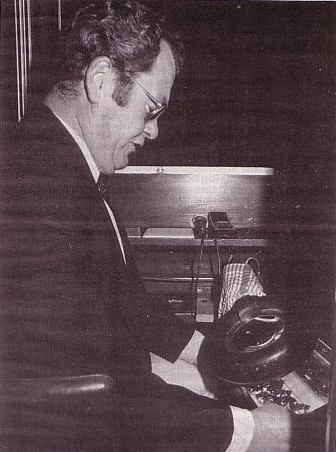| JUDGES |
YEAR: 1988
 |
Don't think Judge Geoff Bruhns gets it easy on racenights at Addington. He will say that his time in the judge's box can be most demanding.
Arriving on-course at least an hour before the first race, the former Prne Gould Guiness deer representative begins his routine by marking the scratchings in his racebook. Geoff then goes up to the judge's box situated at the southern end of the steward's stand and runs through the names of the night's 10 races, in case of any tricky pronunciations. Geoff also checks his Tridex intercom system - which he uses for contacting Totalisator Control and the semaphore board - and his video equipment. After a meal in "Twiggers" with either his assistant Ernie Fuchs or commentator Reon Murtha, Geoff's time for quick but deadly accurate decision-making begins.
Geoff, Ernie and the other assistant, Brent Tweedie, watch each race intently, during which Ernie activates the lap bell from a small switch underneath their wooden bench. As the horses cross the finishing line, Geoff notes down the numbers of the first five home. If it's close for any placing, he replays the last 10 metres on the television between his feet, as a check for his visual call only. If a horse's number is obscured, Geoff will use the trainer's colours to determine what horses are in the call. "While Reon is still talking I call for a photo for first, and any other placing that warrants it," Geoff says. By "call" he means he speaks through a hole in the metal pipe that connects the judge's box with the photographer's room. The photographer acknowledges, and within seconds the required prints are sent down through that pipe.
Just before Geoff announces his initial call to the public, he radios that call through to both the semaphore board and tote control - hence the preliminary dividends that appear on the televisions moments after the race. Confirming his judgement by use of the photos, Geoff relays them, as well as the margins he quickly works out, live on-course.
"I always ask for a photo for first because off that I can work out the time using a lined grid," he said. "When the first horse hits the finishing line it breaks a laser beam which stops the timing of the race. The photos of the first four placings have a decreasing scale of time running across the top of them, and from the photos we can determine each individual time by lining them up with the scale," he said.
During this time, Brent has determined the finishing order of the whole field, not an easy task by any means. Geoff can check this if need be from a 25cm-long strip which most of the time contains the whole field. The strip is in minute form, but he has a lighted madnifying glass at his disposal as well.
After every detail is decided, Geoff goes to the office in the drivers' room and writes the first five placings in the club's official book. "I always place one more horse than a stake is paid to, just in case of a disqualification. If everything goes smoothly, I can have up to 20 minutes to fill in between races, but that doesn't happen often," he said.
Geoff, who will be starting his fifth year as judge at Addington next month, has also been the Riccarton judge for over 10 years. "I judge on colours at Riccarton because I know them better there, I work by numbers at Addington. And the only other difference is that I have to placethe first six home at Riccarton," he said.
Geoff used to be part of a 10-strong syndicate that raced the pacer Money Order. Because it is illegal to have ownership in a horse in such a position, Geoff pulled out of the syndicate a month before he took over at Addington. Money Order won it's one and only race just two months later.
Credit: John Robinson writing in HRWeekly 20Jul88